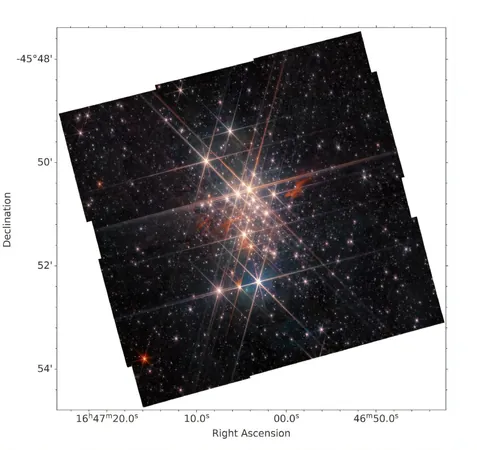
Unveiling the Mysteries of Westerlund 1: A Deep Dive into the Most Massive Star Cluster in Our Galaxy
2024-11-27
Author: Wei
Introduction
An exciting study from an international team of astronomers harnessing the power of the James Webb Space Telescope (JWST) has brought new insights into Westerlund 1, a colossal galactic open cluster that has fascinated scientists for decades. This pioneering observational campaign, detailed in a recent publication, unveils critical details about the structure and properties of this extraordinary star cluster.
What are Open Clusters?
Open clusters, like Westerlund 1, are stellar collections formed from the remnants of a single giant molecular cloud, producing stars that remain loosely gravitationally bound over time. Currently, more than 1,000 such clusters have been identified in the Milky Way, yet many more potentially await discovery. By expanding our catalog of galactic open clusters, astronomers aim to deepen our understanding of the processes that drive the formation and evolution of the galaxy itself.
About Westerlund 1
Westerlund 1, located approximately 13,800 light-years from Earth, stands out not just for its size but for its composition. It is classified as a supermassive star cluster (SSC), with an estimated mass ranging between 50,000 to 100,000 solar masses and a radius of about 3.26 light-years, making it the most massive known cluster in our galaxy. This impressive collection of stars is relatively young, with an estimated age of just 5 to 10 million years.
Research Methodology
Led by astronomer Mario Giuseppe Guarcello from the Palermo Astronomical Observatory in Italy, the research team utilized JWST's state-of-the-art Mid-Infrared Instrument (MIRI) and Near Infrared Camera (NIRCam) to delve further into the characteristics of Westerlund 1. The team's objective was to uncover the members of the cluster, particularly focusing on those that fall into the brown dwarf category and studying protoplanetary disks that may provide clues about the environmental interactions within the cluster.
Key Findings
Their findings revealed an intriguing nebulosity encircling the core of Westerlund 1. The majority of this nebular emission consists of droplet-like features that are aligned with the massive stars within the cluster. Further examination showed a striking elongated feature measuring approximately 3.3 light-years, directed toward the cluster's center, along with groupings of cloud fragments enveloping the massive stars.
Additionally, the team observed extended shells around several M-type supergiants in Westerlund 1, showcasing varied structures. In three cases, these shells exhibited an elongated formation contrary to the cluster's core, while in other observations, narrow outflows emerged in specific directions. These findings hint at a complex interplay between the massive stars and the surrounding material, raising crucial questions about star formation and the life cycles of stars within such dense environments.
Conclusion
The insights gained from JWST observations of Westerlund 1 are poised to enhance our understanding of stellar formation in the Milky Way and beyond. As astronomers continue to explore the universe's myriad wonders, the implications of this research could shape the future of astrophysical studies, revealing even deeper connections within the cosmos. Keep your eyes on the stars – who knows what other secrets they hold!




 Brasil (PT)
Brasil (PT)
 Canada (EN)
Canada (EN)
 Chile (ES)
Chile (ES)
 España (ES)
España (ES)
 France (FR)
France (FR)
 Hong Kong (EN)
Hong Kong (EN)
 Italia (IT)
Italia (IT)
 日本 (JA)
日本 (JA)
 Magyarország (HU)
Magyarország (HU)
 Norge (NO)
Norge (NO)
 Polska (PL)
Polska (PL)
 Schweiz (DE)
Schweiz (DE)
 Singapore (EN)
Singapore (EN)
 Sverige (SV)
Sverige (SV)
 Suomi (FI)
Suomi (FI)
 Türkiye (TR)
Türkiye (TR)